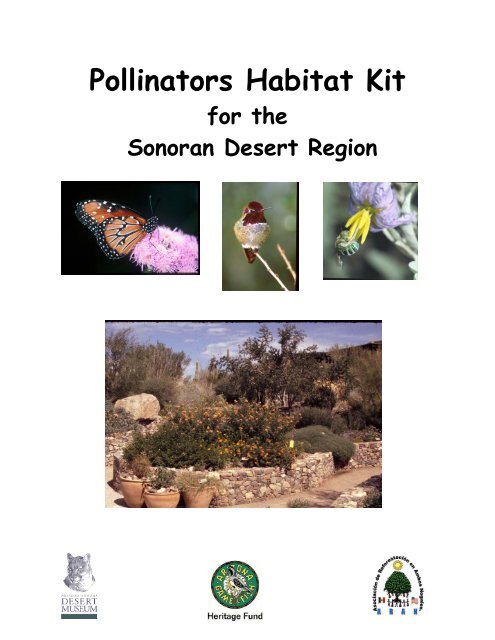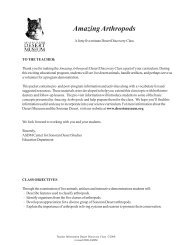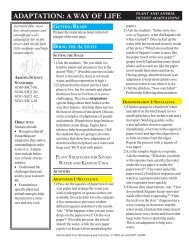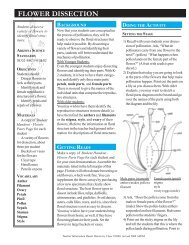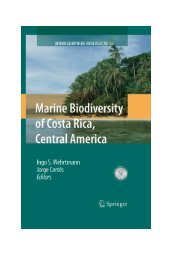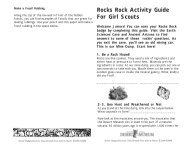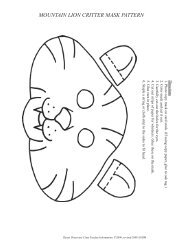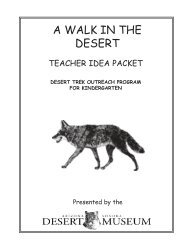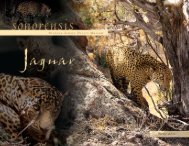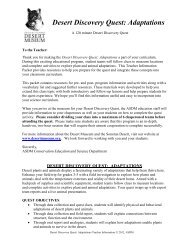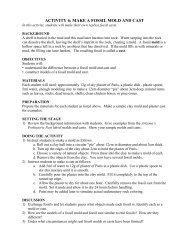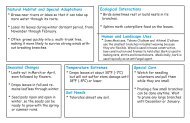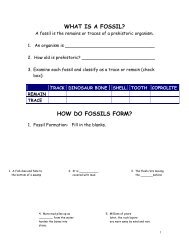Pollinators Habitat Kit - Arizona-Sonora Desert Museum
Pollinators Habitat Kit - Arizona-Sonora Desert Museum
Pollinators Habitat Kit - Arizona-Sonora Desert Museum
You also want an ePaper? Increase the reach of your titles
YUMPU automatically turns print PDFs into web optimized ePapers that Google loves.
<strong>Pollinators</strong> <strong>Habitat</strong> <strong>Kit</strong><br />
for the<br />
<strong>Sonora</strong>n <strong>Desert</strong> Region
Acknowledgments<br />
This project is the result of the collaboration of a very dedicated<br />
interdisciplinary team from the <strong>Arizona</strong> <strong>Sonora</strong> <strong>Desert</strong> <strong>Museum</strong>, who worked<br />
enthusiastically on the design, content, drawings, materials research and<br />
development of this kit. We would like to acknowledge especially the<br />
contributions made by April Baisan, Doug Larson, Kim Duffek, Jaquie<br />
Kahn, Kathy Moore, Axhel Muñoz, Carol Madeheim, Jesús García, and<br />
Robin Kropp.<br />
Our special thanks to Pat and Dale Young, our invaluable volunteers for<br />
their hard work in the creation of this kit and their contribution of<br />
purchasing materials. Teresa Garcia Ruy collaborated with the translation<br />
of some materials, for all of them our deep appreciation.<br />
This project was funded in part for the <strong>Arizona</strong> <strong>Sonora</strong> <strong>Desert</strong> <strong>Museum</strong>,<br />
<strong>Arizona</strong> Game and Fish Department though the Heritage Funds and the<br />
Asociación de Re-vegetación de Ambos Nogales -ARAN.<br />
To all our collaborators…<br />
Thanks!<br />
Yajaira F. Gray<br />
Project Coordinator<br />
<strong>Arizona</strong>-<strong>Sonora</strong> <strong>Desert</strong> <strong>Museum</strong><br />
Copyright © 2006 <strong>Arizona</strong> <strong>Sonora</strong> <strong>Desert</strong> <strong>Museum</strong> - 2 -
DISCLAIMER<br />
The findings, opinions, and recommendations in this report are those of the<br />
investigators who have received partial or full funding from the <strong>Arizona</strong> Game<br />
and Fish Department Heritage Fund. The findings, opinions, and<br />
recommendations do not necessarily reflect those of the <strong>Arizona</strong> Game and Fish<br />
Commission or the Department, or necessarily represent official Department<br />
policy or management practice. For further information, please contact the<br />
<strong>Arizona</strong> Game and Fish Department.<br />
Copyright © 2006 <strong>Arizona</strong> <strong>Sonora</strong> <strong>Desert</strong> <strong>Museum</strong> - 3 -
<strong>Pollinators</strong> <strong>Habitat</strong> <strong>Kit</strong><br />
<strong>Sonora</strong>n <strong>Desert</strong> Region<br />
How to plan, plant, maintain and study in your<br />
Schoolyard Pollinator Garden<br />
How to Use This <strong>Kit</strong><br />
The Teacher’s Manual with the enclosed corresponding resources will provide you and<br />
your students with all the information (and more!) you need to successfully plan, plant,<br />
and maintain a desert pollinator garden at your school. The Manual is intended to be a<br />
step by step guide on how to develop a successful schoolyard pollinator garden, complete<br />
with background information, resources, and student activities.<br />
The Teacher’s Manual is divided into the following sections:<br />
• Chapter 1. Introduction and Background Information<br />
• Chapter 2. Guide to Developing the Garden<br />
Planning the Garden Project<br />
Step 1: Developing a Proposal<br />
Step 2: Planning the Garden<br />
Step 3: Designing the Garden<br />
Breaking Ground<br />
Step 4: Preparing the Site<br />
Step 5: Planting the Garden<br />
Maintaining the Garden<br />
Step 6: Ongoing Garden Maintenance and Care<br />
Step 7: Using the Garden as A Study Site<br />
• Chapter 3. Resources<br />
• Appendices<br />
- Garden Designs<br />
- Plants Lists and information<br />
Each section in the Guide to Developing the Garden chapter begins with a checklist of<br />
suggested steps to follow. More detailed information describing each step is found on the<br />
pages following the checklist. There are numerous publications on “how to develop a<br />
schoolyard garden” and we’ve included some of the best in this kit. Specific pages in<br />
these reference materials are correlated to each section in our Teacher’s Manual. As you<br />
follow the steps in each chapter, please read the corresponding information in these<br />
reference materials, as there are important helpful details in these books and pamphlets.<br />
Copyright © 2006 <strong>Arizona</strong> <strong>Sonora</strong> <strong>Desert</strong> <strong>Museum</strong> - 4 -
Chapter 1<br />
Introduction and Background<br />
Information<br />
Copyright © 2006 <strong>Arizona</strong> <strong>Sonora</strong> <strong>Desert</strong> <strong>Museum</strong> - 5 -
<strong>Pollinators</strong> <strong>Habitat</strong> <strong>Kit</strong><br />
How to plan, plant, maintain and study in your Schoolyard Pollinator Garden<br />
Introduction<br />
Children are natural-born scientists innately curious about the world around them.<br />
Creating a schoolyard garden offers children the opportunity to learn and discover so<br />
much about their environment and themselves as well as gives them a chance to work as<br />
part of a team within their school community. The garden can become a powerful<br />
teaching tool for creative academic and social lessons.<br />
Your students should be involved in the entire process of developing the garden; from<br />
planning, designing and planting the garden, to keeping up with ongoing garden<br />
maintenance. The more ownership children have in the garden, the more likely it will be<br />
maintained and cherished over the years.<br />
Many of the <strong>Arizona</strong> and National Academic Standards in all subject areas can be<br />
applied in the garden. Gardens inspire students to write and indeed give them something<br />
to write about “School gardens challenge students to learn the principles of ecology – the<br />
language of nature.” (Getting Started 1997) In the garden, students keep records on the<br />
development of the project; take measurements and graph plant growth; observe plant<br />
and animal interactions; carry out inquiry-based scientific investigations, communicate<br />
their findings both orally and in writing; make public presentations, and more!...The<br />
opportunities for exciting discovery and meaningful learning are endless.<br />
Copyright © 2006 <strong>Arizona</strong> <strong>Sonora</strong> <strong>Desert</strong> <strong>Museum</strong> - 6 -
Pollination: Plant and Animal Interactions<br />
Background Information<br />
Pollination<br />
In every garden, the life cycle of a plant can be observed, from seed, to seedling, to<br />
mature plant, to flower, to fruit, and to a new seed again. Flowers are the primary sites of<br />
reproduction in most plants (see figure 1). As in animal reproduction, sperm and egg<br />
must join in order fertilization to occur. In flowering plants, pollen bears the sperm and<br />
the eggs are found deep inside the female tissue (ovaries) of the flower in the form of<br />
undeveloped seeds. The male and female organs that produce sperm and egg are most<br />
often (but not always) found within the same flower.<br />
Let’s look more closely at the parts of a flower (see figure1). The stamen is the male<br />
part of a flower consisting of the anthers suspended on the filaments. The anthers bear<br />
the pollen. The pistil is the female part of the flower comprised of the stigma, the style,<br />
and the ovary.<br />
Here’s how fertilization occurs. (Refer to figures 1 and 2 as you read on.) When a pollen<br />
grain from one flower lands of the stigma of another flower of the same species, a pollen<br />
tube grows down through the style to the eggs (ovules) within the ovary. Where the tube<br />
enters the ovules sperm is deposited and fertilization occurs. (Note: This process is<br />
clearly illustrated in the video, The Magic School Bus Goes to Seed.)<br />
Once fertilized, the ovules develop into seeds and the ovary forms a fruit surrounding the<br />
seeds. Thus an apple is a swollen ovary surrounding fertilized seeds.<br />
Pollination is vital to plant reproduction. Some flowering plants are wind-pollinated,<br />
others are self-pollinated, but most (80%) require insects or other animals to pollinate<br />
their flowers. A fertilized flower is more likely to produce full-bodied fruit with viable<br />
seeds, while unfertilized flowers may wither away without producing seeds. Thus, plants<br />
invest a great deal of energy to attract animal pollinators.<br />
Flowers exhibit a wide variety of shapes, colors, sizes, and fragrances depending on the<br />
types of pollinator they attract. For example, hummingbirds are attracted to red, orange,<br />
and yellow tubular shaped flowers with lots of sweet nectar. Butterflies prefer bright<br />
yellow flowers with flat landing areas such as daisies and desert marigolds.<br />
The relationship between pollinators and plants are an example of mutualism in which<br />
both the plant and animal benefit from the arrangement. Plants receive pollination<br />
services to ensure the production of their fruit and seeds. <strong>Pollinators</strong> receive rewards<br />
such as nectar, pollen, and fragrant oils. The most common reward given by the plant in<br />
Copyright © 2006 <strong>Arizona</strong> <strong>Sonora</strong> <strong>Desert</strong> <strong>Museum</strong> - 7 -
this exchange is nectar. Nectar provides a high-energy food source for pollinators. It is<br />
the fuel that feeds their flight.<br />
Parts of A Flower<br />
Petals – Surround and protect inner parts of a flower. This flower part (often brightly colored,<br />
sometimes scented) plays an important role in pollination as the attractant for pollinators.<br />
Sepals – similar to leaves, which cover and protect the growing flower when it is a bud.<br />
1. Stigma: sticky part on top of the style that catches the pollen grains.<br />
Copyright © 2006 <strong>Arizona</strong> <strong>Sonora</strong> <strong>Desert</strong> <strong>Museum</strong> - 8 -
2. Style: stalk that comes out of the ovary; pollen tube grows down the style & sperm<br />
travels down tube and fertilizes egg cells in the ovary.<br />
3. Ovary: where the egg cells grow; ovary swells to form fruit around the seeds.<br />
Stationary and Migratory <strong>Pollinators</strong><br />
The food provided by flowers is utilized by a variety of pollinators. Some pollinators are<br />
year-round residents of the area and spend their entire lives near the place where they<br />
were born. These resident pollinators include Anna’s hummingbird, queen butterfly,<br />
cactus bees, and carpenter bees among others.<br />
Other pollinators are migratory and travel seasonally from one place or habitat to another<br />
to avoid unfavorable climatic conditions and/or to seek more favorable food conditions.<br />
They migrate great distances to obtain the nectar fuel the flowers provide. Among those<br />
migratory pollinators are rufous hummingbirds, monarch butterflies, lesser long-nose<br />
bats.<br />
<strong>Pollinators</strong> and People<br />
The pollinators are very important to our existence as well. Aside from the pleasure we<br />
derive from seeing flowering plants, more than three-quarters of the crop plants that feed<br />
the world, as well as many of the plants from which we derive medicines for our<br />
pharmacies, rely on pollination by insects or other animals to produce healthy fruits and<br />
seeds. Pollination is critical to commercial orchard and field-crop production, endangered<br />
species protection, urban gardening, ecological restoration and forage production for the<br />
diary and beef industry.<br />
<strong>Pollinators</strong> in Trouble<br />
Current evidence suggests that populations of some pollinators are declining because of<br />
habitat loss and fragmentation, pesticide use, and the effects of invasive species. As<br />
towns and cities expand into the desert, native plants are destroyed reducing food<br />
supplies and nesting sites for pollinators. Even when a small parcel of desert land is set<br />
aside for wildlife, these “islands” are often so far apart that migratory pollinators can’t<br />
find enough food to move from place to place. This is called habitat fragmentation.<br />
Invasive, non-native plants, such as buffel grass, grow so fast that they out-compete<br />
native plants, reducing food supplies for pollinators. Pesticides, used to kill weeds and<br />
undesirable insects often kill native plants and pollinators as well.<br />
<strong>Arizona</strong> <strong>Sonora</strong> <strong>Desert</strong> <strong>Museum</strong> Migratory Pollinator Program<br />
Among these native pollinators in trouble are four migratory pollinators: lesser long-nose<br />
bat, rufous hummingbird, white-winged dove, and monarch butterfly. All four travel<br />
between Mexico and the USA each year. Three of these species were the focus of study<br />
of the Migratory Pollinator Program of the <strong>Arizona</strong>-<strong>Sonora</strong> <strong>Desert</strong> <strong>Museum</strong>, from 1999<br />
through 2002. This bi-national collaborative research and education program included<br />
participation from local communities, teachers, organizations, researchers, and citizens<br />
concerned about the conservation of migratory pollinators across borders. To find out<br />
more about the results from this program, visit our website at<br />
http://www.desertmuseum.org/pollination/index.html<br />
Copyright © 2006 <strong>Arizona</strong> <strong>Sonora</strong> <strong>Desert</strong> <strong>Museum</strong> - 9 -
Importance of Pollinator Gardens<br />
You and your students can be part of the solution! Establish a desert pollinator garden at<br />
your school and provide a safe and friendly environment for our resident and migratory<br />
pollinators. Although humans have displaced native habitats by building our homes,<br />
schools, businesses, and farms, we can restore some of them by providing plants that<br />
offer food and shelter for pollinators. Your garden can include species that are attractive<br />
to a range of pollinators including butterflies, moths, bees, hummingbirds and bats. You<br />
can also provide supplemental food such as hummingbird feeders, or shelter such as bat<br />
houses or native bee shelters.<br />
Follow the instructions in this kit to get started. Remember, start small and keep your<br />
project manageable. Even small gardens can help our pollinators!<br />
Copyright © 2006 <strong>Arizona</strong> <strong>Sonora</strong> <strong>Desert</strong> <strong>Museum</strong> - 10 -
Involving Students: Corresponding Student Activities<br />
and Information<br />
ASDM Activities:<br />
• Forgotten Pollinator’s Slide Show: CD and script with Discussion Questions<br />
• Flower Dissection<br />
• Bats, Bees, Birds, and Blossoms.<br />
• Bats: Need Nectar, Will Travel<br />
The slide show and corresponding activities will help children develop an<br />
understanding of the link between plants and their pollinators, and some of the<br />
problems pollinators currently face. Students will learn that they can be part of the<br />
solution by planting a garden to attract and provide food for native pollinators.<br />
Activity Books:<br />
<strong>Desert</strong> Birding in <strong>Arizona</strong> With a Focus on Urban Birds: Lesson Ten: Incredible<br />
Journeys How and Why Birds Migrate; Troubles Along the Way; Some Tucson<br />
Migrants pp. 79-90.<br />
Children’s Books:<br />
Flute’s Journey<br />
Cactus Café<br />
Magic School Bus Goes to Seed<br />
Flowers for Lucia<br />
Video<br />
Magic School Bus Plants Seeds<br />
Copyright © 2006 <strong>Arizona</strong> <strong>Sonora</strong> <strong>Desert</strong> <strong>Museum</strong> - 11 -
CHAPTER 2<br />
THE PROCESS OF DEVELOPING<br />
A SCHOOLYARD POLLINATOR<br />
GARDEN
Chapter 2: The Process of Developing a<br />
Schoolyard Pollinator Garden<br />
CHECKLIST<br />
Below is a checklist of reminders and suggested tasks to complete as you develop<br />
your garden. More information explaining each item, along with resources and<br />
suggested student activities, is included on the pages following this list.<br />
PLANNING THE GARDEN PROJECT<br />
STEP 1: DEVELOPING A PROPOSAL<br />
_____ Start a Garden Record Book<br />
_____ Gather Resource Information<br />
_____ Subscribe to the National Gardening Association’s Free, Biweekly,<br />
Electronic Regional Report (http://www.nationalgardening.com)<br />
_____ Determine the Purpose for the Garden<br />
_____ Identify Potential Sites<br />
_____ Identify and Meet with Potential Project Co-leaders<br />
_____ Outline Project Requirements<br />
_____ Prepare a Preliminary Budget<br />
_____ Start a Garden Advisory Committee<br />
_____ Identify Potential Funding Sources and Donors of Materials<br />
_____ Keep Your School Community Informed<br />
<strong>Pollinators</strong> <strong>Habitat</strong> <strong>Kit</strong> © <strong>Arizona</strong>-<strong>Sonora</strong> <strong>Desert</strong> <strong>Museum</strong>, 2007.<br />
14
STEP 2: PLANNING THE GARDEN<br />
_____ Begin a Classroom Garden Journal<br />
_____ Determine A Garden Theme<br />
_____ Select a Site<br />
_____ Site Analysis: Map and Inventory the Site; Identify Site Needs<br />
_____ Discuss Plans For Ongoing Garden Maintenance<br />
_____ Develop a Timeline for the Project<br />
_____ Revisit and Update the Budget<br />
_____ Write Grants and Conduct Fund Raising Activities<br />
_____ Keep Your School Community Informed<br />
STEP 3: DESIGNING THE GARDEN<br />
_____ Create a Preliminary Design<br />
_____ Select Appropriate Plants<br />
_____ Design the Water System<br />
_____ Finalize the Garden Design<br />
_____ Make a Shopping List<br />
_____ Complete Any School District Paperwork<br />
_____ Finalize the Budget<br />
_____ Keep Your School Community Informed<br />
<strong>Pollinators</strong> <strong>Habitat</strong> <strong>Kit</strong> © <strong>Arizona</strong>-<strong>Sonora</strong> <strong>Desert</strong> <strong>Museum</strong>, 2007.<br />
15
STEP 4: PREPARING THE SITE<br />
COORDINATING THE PROJECT<br />
____ Purchase Gardening Equipment<br />
____<br />
____<br />
____<br />
Establish Guidelines with Students and Community Members for Working in the<br />
Garden<br />
Coordinate Volunteer and Student Teams<br />
Schedule and Organize Work Days<br />
SITE PREPARATION<br />
____ Remove Surface Debris<br />
____<br />
____<br />
____<br />
____<br />
____<br />
____<br />
Remove “Weed” Species and Destroy Bermuda grass<br />
Test and Prepare the Soil<br />
Install the Drip Irrigation System<br />
Add Other Required Structures<br />
Construct Paths and Delineate Planting Areas<br />
Keep Your School Community Informed<br />
STEP 5: PLANTING THE GARDEN<br />
COORDINATING THE PROJECT<br />
____<br />
____<br />
____<br />
Determine the Appropriate Planting Times for Plants and Seeds<br />
Planting Trees<br />
Planting Herbaceous Plants<br />
____ Sowing Seed<br />
____<br />
____<br />
____<br />
____<br />
____<br />
____<br />
Purchase Plants and Seeds<br />
Establish Guidelines with Students and Community Members for Working in<br />
the Garden<br />
Coordinate Volunteer and Student Teams<br />
Schedule and Organize Planting Days<br />
Provide Recognition for Garden Volunteers and Funding Sources<br />
Organize a Garden Ribbon-Cutting Celebration<br />
<strong>Pollinators</strong> <strong>Habitat</strong> <strong>Kit</strong> © <strong>Arizona</strong>-<strong>Sonora</strong> <strong>Desert</strong> <strong>Museum</strong>, 2007.<br />
16
STEP 6: ONGOING GARDEN MAINTENANCE<br />
AND CARE<br />
____ Develop and Write Plan for Ongoing Maintenance<br />
____ Preventing Vandalism<br />
____<br />
____ Water<br />
Periodically Check Plant Health<br />
____ Weed removal<br />
____ Pruning<br />
____ Fertilizer<br />
____ Garden Pests<br />
____ Seasonal Care<br />
____ Repairs<br />
STEP 7: USING THE GARDEN AS AN OUTDOOR<br />
CLASSROOM AND GATHERING AREA<br />
____ Establish Garden Rules<br />
____ Special Events<br />
____<br />
Study Methods and Themes<br />
<strong>Pollinators</strong> <strong>Habitat</strong> <strong>Kit</strong> © <strong>Arizona</strong>-<strong>Sonora</strong> <strong>Desert</strong> <strong>Museum</strong>, 2007.<br />
17
Chapter 2: The Process of Developing a<br />
Schoolyard Pollinator Garden<br />
PLANNING THE GARDEN PROJECT<br />
STEP 1: DEVELOPING A PROPOSAL<br />
<strong>Pollinators</strong> <strong>Habitat</strong> <strong>Kit</strong> © <strong>Arizona</strong>-<strong>Sonora</strong> <strong>Desert</strong> <strong>Museum</strong>, 2007.<br />
18
STEP 1: DEVELOPING A PROPOSAL<br />
Start a Garden Record Book: Keep records of all meetings, people involved, and<br />
thoughts as you proceed.<br />
Gather Resource Information: Review the reference material in this kit.<br />
Subscribe to the National Gardening Association’s Free, Biweekly, Electronic<br />
Regional Report (http://www.nationalgardening.com):<br />
These biweekly Regional Gardening Reports are full of excellent, timely, local<br />
gardening information written by regional experts, and include a short feature,<br />
garden reminders, favorite plants, local events and more. To receive your free<br />
newsletters, go to the website and complete the form.<br />
Determine the Purpose for the Garden:<br />
Do you want to provide habitat for specific pollinators and/or many species of<br />
desert wildlife Will this be an outdoor student learning area for science, and/or a<br />
quiet area for journaling and reading Will school and/or community gatherings<br />
occur here The purpose for the garden will evolve as the project proceeds.<br />
Identify Potential Sites<br />
Be prepared to present these at initial meetings.<br />
Identify and Meet with Potential Project Co-leaders<br />
Find out if other teachers and staffs are interested in becoming actively involved<br />
as leaders in this project. Meet with this core group and discuss the purpose for<br />
the garden, project requirements, and how they can contribute.<br />
Outline Project Requirements<br />
Include initial and ongoing needs for materials, participants, space, and funding.<br />
Some materials to consider include tools, fencing, additional soil, fertilizer,<br />
compost, block, site preparation equipment (tillers, etc.), irrigation materials, and<br />
plants.<br />
Prepare a Preliminary Budget<br />
The budget will vary depending upon the site size and project requirements<br />
outlined above. In addition, be sure to consider curriculum materials and science<br />
field equipment.<br />
Start a Garden Advisory Committee<br />
Once you have met with your school administrators and core group, it is<br />
important to build a larger team of support for the garden project. You might<br />
invite school board members, teachers, administrators, PTA members, parent<br />
liaisons, community members, and of course students to serve on the committee.<br />
<strong>Pollinators</strong> <strong>Habitat</strong> <strong>Kit</strong> © <strong>Arizona</strong>-<strong>Sonora</strong> <strong>Desert</strong> <strong>Museum</strong>, 2007.<br />
19
Be sure to include school maintenance staff. The scope of your project will<br />
determine committee make-up and size. Once the group is established, you might<br />
want to select committee leaders. Begin to consider the rolls of various<br />
participants.<br />
Identify Potential Funding Sources and Donors of Materials<br />
It is important to think about sources for project funds early. First, meet with<br />
your principal to determine if any district funding might be available. Then begin<br />
looking for potential donors of materials or funds including local businesses and<br />
private donors. Consider applying for grants. For funding tips and grant sources<br />
refer to Chapter 3 Resources Funding Sources in this manual, and Appendix 2.<br />
Keep Your School Community Informed<br />
Throughout the project be sure to keep your school community (administrators,<br />
staff, parents, students, local businesses, etc.) informed of garden activities.<br />
Flyers, emails, articles in your school’s newsletters are some ways to do this.<br />
This will encourage community involvement and help with fundraising efforts.<br />
For more detailed information on developing a proposal, refer to<br />
appendix 1 and the following materials in this kit:<br />
• Getting Started, A Guide for Creating School Gardens as Outdoor Classrooms<br />
pp.9-13, Raising Funds and More 30-35.<br />
• Success with School Gardens - Cultivating Support and Sprouting Volunteers: pp<br />
13-18; 23-28; and Appendix E, Funding Sources and Grants: pp.113-115.<br />
• Wild School Sites, A Guide to Preparing for <strong>Habitat</strong> Improvement Projects on<br />
School Grounds - Team Building pp. 20-28, Sample Parent Letter p. 50.<br />
Involving Students- Corresponding Student Activities:<br />
The students could do research on plants (light and soil requirements, pollinators,<br />
water needs, frost tolerance, availability, prices, etc.), irrigation systems (types,<br />
prices), gardens tools (list of tools needed, prices comparison), etc. They can create a<br />
report to present to others members of the proposal committee. These activities could<br />
have math, reading, and writing components.<br />
<strong>Pollinators</strong> <strong>Habitat</strong> <strong>Kit</strong> © <strong>Arizona</strong>-<strong>Sonora</strong> <strong>Desert</strong> <strong>Museum</strong>, 2007.<br />
20
STEP 2: PLANNING THE GARDEN<br />
Begin a Classroom Garden Journal<br />
Now that your project is public and has tentatively been approved, it’s a perfect<br />
time to teach students to keep good records as the garden plan evolves.<br />
Determine A Garden Theme<br />
Will this be a garden to attract specific pollinators such as butterflies, bees, birds,<br />
and/or mammals for students to study Do you want only native vegetation or<br />
will other desert-adapted plants be acceptable Refer to the purpose of the garden<br />
as you consider themes.<br />
Select a Site<br />
This is a very important step and a lot of thought should go into this decision.<br />
Consider sunlight, shade, water, drainage, faucet locations, slope, accessibility,<br />
security, visibility, soil type, pedestrian traffic, and potential for expansion.<br />
Site Analysis<br />
Map and Inventory the Site<br />
Measure and draw the garden area to scale. Label existing plants and<br />
structures that will remain. Distinguish these on your map from the plants and<br />
structures that will be removed.<br />
Identify Site Needs<br />
What is needed to attract the wildlife you desire and enable students to<br />
comfortably work and make observations in the garden What structures are<br />
needed to support the plants (watering system, etc.)<br />
Discuss Plans For Ongoing Garden Maintenance<br />
This is an important early step in ensuring the garden will be cared for over the<br />
years. Identify people that can take care of the garden during school breaks and in<br />
the future.<br />
Develop a Timeline for the Project<br />
Remember, every step may take longer than you plan!<br />
Revisit and Update the Budget<br />
At this point you can review the estimates costs and adjust the budget with the<br />
funds available.<br />
Write Grants and Conduct Fund Raising Activities<br />
Students, parents, and teachers can work together on different activities such us:<br />
plant sales (students can germinate seeds and sale the seedlings), holding special<br />
<strong>Pollinators</strong> <strong>Habitat</strong> <strong>Kit</strong> © <strong>Arizona</strong>-<strong>Sonora</strong> <strong>Desert</strong> <strong>Museum</strong>, 2007.<br />
21
events (raffles, food and garage sales), selling investments for the garden (tiles/stones<br />
with donor’s name)<br />
Keep Your School Community Informed<br />
Throughout the project be sure to keep your school community (administrators,<br />
staff, parents, students, local businesses, etc.) informed of garden activities.<br />
Flyers, emails, articles in your school’s newsletters are some ways to do this.<br />
Encourage community involvement!<br />
For more detailed information on planning the garden, refer to<br />
appendix 2 and the following materials in this kit:<br />
• Wild School Sites: Creating the Plan, pp: 28-39 (Includes detailed information on<br />
the site inventory and mapping)<br />
• Getting Started: Selecting The Site, pp: 15-22.<br />
• Success with School Gardens: Chapter 5 - Finding a Row to Hoe: pp: 37-42; 94-<br />
95.<br />
• Getting Started: Meeting the Challenge, pp: 27-40<br />
• Success with School Gardens: Chapter 3 –Leave no Stone Unturned<br />
The following books and magazine are included with the kit:<br />
• Schoolyard Mosaics, designing gardens and habitats. National Gardening<br />
Association.<br />
• Basics for creating a schoolyard habitat. Southwest Center for Education and the<br />
Natural Environment: pp 8-9.<br />
• Sonorensis Gardening The <strong>Desert</strong> <strong>Museum</strong> Way: ASDM Design Process, pp. 5-9<br />
Involving Students- Corresponding Student Activities:<br />
Creating A Garden Journal – ASDM journal activity can be modified so students can<br />
log the process beginning with why students want a garden…inventory of site…<br />
Site Mapping Activity included in Wild School sites (project WILD)<br />
Field Trips<br />
For inspiration and ideas, visit Tucson Botanical Gardens, Tohono Chul Park, or<br />
the gardens at the <strong>Desert</strong> <strong>Museum</strong> (see Chapter 3 Resources list). You might be<br />
able to arrange for a guided garden tour geared towards designing a garden.<br />
<strong>Pollinators</strong> <strong>Habitat</strong> <strong>Kit</strong> © <strong>Arizona</strong>-<strong>Sonora</strong> <strong>Desert</strong> <strong>Museum</strong>, 2007.<br />
22
STEP 3: DESIGNING THE GARDEN<br />
Create a Preliminary Design<br />
Make a copy of your map of the garden site. Be sure existing structures and<br />
plants that will remain in the space are drawn and labeled. Draw and label plans<br />
for the garden. Include planting areas and structures in this plan. Consider<br />
meeting areas, benches, an experimental area, a perimeter fence - to keep<br />
unwanted animals out such as hungry rabbits, tool shed, and water spigots.<br />
Remember this is a working sketch and plans will change. Keep the initial garden<br />
size and design manageable – you can always expand!<br />
Select Appropriate Plants<br />
Begin by reviewing the plethora of plant information, including the plant cards,<br />
contained in this kit. Make a list of the plant species the garden might support.<br />
Review your site map and existing plant inventory along with the list of plants<br />
needed to support wildlife (from your needs list).<br />
Design the Water System<br />
Easy access to water is a critical element to consider when you are designing your<br />
garden. There are various systems that you can consider. Drip irrigation systems<br />
are an efficient and water saving alternative, especially in desert areas. Overhead<br />
watering or watering cans or buckets can be also an alternative, especially is your<br />
garden isn’t too large, (for more details see chapter 5 and 11 of Success with<br />
School Gardens).<br />
Finalize the Garden Design<br />
At this point you should have a design with all the details to establish the<br />
pollinators habitat. The drawings should include labels for plants, structures,<br />
walking areas, etc. The accuracy of the measurements is essential for the success<br />
of the project.<br />
Make a Shopping List<br />
This shopping list should include garden tools (shovels, digging bars, hoses, etc.),<br />
plants (use common and scientific names), irrigation system, and other materials<br />
to install and maintain the habitat (chicken wire, rocks, table, benches, etc). You<br />
can include a wish list for special items or professional services that could be<br />
donated.<br />
Complete any School District Paperwork<br />
Each school district has its own set of paperwork that needs to be completed<br />
before a project can be implemented. Meet with your principal and maintenance<br />
department to be sure all paperwork is completed properly and your project is in<br />
compliance with district rules.<br />
<strong>Pollinators</strong> <strong>Habitat</strong> <strong>Kit</strong> © <strong>Arizona</strong>-<strong>Sonora</strong> <strong>Desert</strong> <strong>Museum</strong>, 2007.<br />
23
Finalize the Budget<br />
Now that the design has been finalized adjust your budget to cover the costs.<br />
Make lists of materials and contact various suppliers to find the best prices. Some<br />
retailers will give discounts to schools.<br />
Keep Your School Community Informed<br />
Throughout the project be sure to keep your school community (administrators,<br />
staff, parents, students, local businesses, etc.) informed of garden activities.<br />
Flyers, emails, articles in your school’s newsletters are some ways to do this.<br />
Encourage community involvement!<br />
For more detailed information on designing the garden, refer to the<br />
following materials in this kit:<br />
ASDM <strong>Desert</strong> Garden <strong>Pollinators</strong>/Plant Cards<br />
ASDM Sample designs<br />
Books and Pamphlets<br />
• <strong>Arizona</strong> Native Plant Society Pamphlets: <strong>Desert</strong> Trees, <strong>Desert</strong> Ground Covers<br />
and Vines, <strong>Desert</strong> Accent Plants, <strong>Desert</strong> Wildflowers, <strong>Desert</strong> Grasses, <strong>Desert</strong> Bird<br />
Gardening<br />
• Sonorensis: Gardening the <strong>Desert</strong> <strong>Museum</strong> Way: ASDM Design Process, pp. 5-9;<br />
Plant Selection Guidelines pp.10-15; Pollinator Gardening p. 20.<br />
• Success with School Gardens pp. 41-42, 58, 60<br />
• Schoolyard Mosaics, designing gardens and habitats. National Gardening<br />
Association.<br />
• Basics for creating a schoolyard habitat. Southwest Center for Education and the<br />
Natural Environment: pp 8-9.<br />
• Native Plants for Southwestern Landscapes<br />
Involving Students- Corresponding Student Activities:<br />
• Designing the <strong>Habitat</strong>- ASDM <strong>Desert</strong> Garden <strong>Pollinators</strong>/Plants Cards included<br />
in this <strong>Kit</strong> can be used to select the pollinators that you would like to attract and<br />
the plants that are most appropriate for their needs. The plant’s growth and<br />
nourishment requirement information (soil, water, temperature, etc) provided in<br />
the cards allow you to decide which plants are appropriate for your schoolyard<br />
habitat.<br />
• Sand Pit Design Activity – Children design garden in a sand pit and teacher<br />
transfers’ 3-D design onto paper.<br />
<strong>Pollinators</strong> <strong>Habitat</strong> <strong>Kit</strong> © <strong>Arizona</strong>-<strong>Sonora</strong> <strong>Desert</strong> <strong>Museum</strong>, 2007.<br />
24
• Felt Board Design Activity, using different symbols to represent plants, and<br />
elements of the gardens (paths, water futures, beds, containers, etc) to create a<br />
preliminary garden design.<br />
Field Trips<br />
• Botanical Gardens: For inspiration and ideas, visit Tucson Botanical Gardens,<br />
Tohono Chul Park, or the gardens at the <strong>Desert</strong> <strong>Museum</strong> (see resource list). You<br />
might be able to arrange for a guided garden tour geared towards designing a<br />
garden.<br />
• Schoolyard Gardens/<strong>Habitat</strong>s: You also might want to stop by other schoolyard<br />
gardens. Model projects can be seen at Kalsa Montesori Elementary School,<br />
Thornydale Elementary School Drachman Elementary Montessori Magnet<br />
School, Miles Exploratory Learning Center.<br />
<strong>Pollinators</strong> <strong>Habitat</strong> <strong>Kit</strong> © <strong>Arizona</strong>-<strong>Sonora</strong> <strong>Desert</strong> <strong>Museum</strong>, 2007.<br />
25
BREAKING GROUND<br />
STEP 4: PREPARING THE SITE<br />
COORDINATING THE PROJECT<br />
Purchase Gardening Equipment<br />
Check list of donated tools and compare with list of needed items. Larger tools<br />
may be rented or loaned from local distributors.<br />
Establish Guidelines with Students and Community Members for Working in<br />
the Garden<br />
Establish garden rules and schedules and demonstrate to students the proper and<br />
improper use of tools.<br />
Coordinate Volunteer and Student Teams<br />
Set up your garden orientation meeting for students and volunteers.<br />
Schedule and Organize Work Days<br />
Set up initial workday around a calendar event like Earth Day, Arbor Day, or<br />
Sustainability week.<br />
SITE PREPARATION<br />
Remove Surface Debris<br />
Clear space for the garden and make sure there are no obstacles in the designated<br />
area that will interfere with the garden design like stumps, fence posts, and large<br />
boulders.<br />
Remove “Weed” Species and Destroy Bermuda grass<br />
Undesirable plants need to be properly removed from the garden to ensure they<br />
will not re-invade once the garden is planted. Bermuda grass is aggressively<br />
invasive and difficult to remove. Any part of this plant’s root will re-grow.<br />
Test and Prepare the Soil<br />
Test major soil nutrients (Nitrogen, Phosporus, Postassium), rototill soil, amend<br />
soil If necessary, add topsoil, organic matter and other soil amendments. Double<br />
dig the soil to loosen soil to a depth of 24 inches. Build raised or traditional<br />
sunken beds garden site.<br />
Install the Drip Irrigation System<br />
This is an activity that can be done by a professional company or students, parents<br />
and teachers can have a special event to make this happen.<br />
Add Other Required Structures<br />
Add any other structures, such as a perimeter fence, tool shed/storage area, the<br />
compost area, and outdoor staging area that need to be in place prior to planting.<br />
<strong>Pollinators</strong> <strong>Habitat</strong> <strong>Kit</strong> © <strong>Arizona</strong>-<strong>Sonora</strong> <strong>Desert</strong> <strong>Museum</strong>, 2007.<br />
26
Construct Paths and Delineate Planting Areas<br />
The path should be wide enough to allow wheel chairs, strollers to move easily.<br />
The planting areas can be delineate using different colors of can sprays.<br />
Keep Your School Community Informed<br />
Throughout the project be sure to keep your school community (administrators,<br />
staff, parents, students, local businesses, etc.) informed of garden activities.<br />
Flyers, emails, articles in your school’s newsletters are some ways to do this.<br />
Encourage community involvement!<br />
For more detailed information on preparing the site, refer to<br />
appendix 3 and the following materials in this kit:<br />
• Getting Started, A Guide for Creating School Gardens as Outdoor Classrooms<br />
Preparing the Garden Site. pp. 23-29<br />
• Success with School Gardens - Chapter 7, Battling Bermuda: pp.55-57<br />
Involving Students- Corresponding Student Activities:<br />
From creating invitations and planning for refreshments to assisting with<br />
scheduling, students can easily be involved in coordinating the work project.<br />
After all the garden planning and anticipation, students will be so excited to<br />
finally get into the garden and get their hands dirty! As soil is turned, be prepared<br />
to share in the excitement of student discoveries. Be sure students document their<br />
discoveries, progress, and interpretations in their journal. There are lots of<br />
opportunities for creative writing and artwork.<br />
<strong>Pollinators</strong> <strong>Habitat</strong> <strong>Kit</strong> © <strong>Arizona</strong>-<strong>Sonora</strong> <strong>Desert</strong> <strong>Museum</strong>, 2007.<br />
27
STEP 5: PLANTING THE GARDEN<br />
COORDINATING THE PROJECT<br />
Organize a Garden Ribbon-Cutting Celebration<br />
A good publicity committee composed of students is important to get the word<br />
out to the school and local community. Make a call to action! Students can video<br />
tape their peers in action—planting trees, constructing compost boxes and give<br />
the tape to local television stations.<br />
Determine the Appropriate Planting Times for Plants and Seeds<br />
Distribute planting calendars to your students and volunteers. These are<br />
suggested guidelines based on local climate that should provide the highest<br />
probability of success.<br />
Planting Trees<br />
Planting Herbaceous Plants<br />
Sowing Seed<br />
Purchase Plants and Seeds<br />
Establish Guidelines with Students and Community Members for Working in<br />
the Garden<br />
Coordinate Volunteer and Student Teams<br />
Schedule and Organize Planting Days<br />
Provide Recognition for Garden Volunteers and Funding Sources<br />
For more detailed information on planting the garden, refer to<br />
appendix 4 and the following materials in this kit:<br />
• Success with School Gardens – Appendix F- Planting calendars 115-125<br />
• Wild School Sites, A Guide to Preparing for <strong>Habitat</strong> Improvement Projects on<br />
School Grounds – Doing It: Putting The Plan into Action: pp. 40-45.<br />
<strong>Pollinators</strong> <strong>Habitat</strong> <strong>Kit</strong> © <strong>Arizona</strong>-<strong>Sonora</strong> <strong>Desert</strong> <strong>Museum</strong>, 2007.<br />
28
STEP 6: ONGOING GARDEN MAINTENANCE<br />
AND CARE<br />
Develop and Write Plan for Ongoing a Maintenance<br />
List specific tasks and identify volunteers to take care of each.<br />
Summer and School Breaks<br />
Summer maintenance is an important consideration. Plan and schedule needed<br />
community caretakers in the summer.<br />
Preventing Vandalism<br />
The more people who are involved in creating the project and share ownership for<br />
its success, the less likely there will be vandalism. Make off hours campus<br />
security aware of the site.<br />
Periodically Check Plant Health<br />
Have students keep track of plant health and growth in their journals. Contact<br />
local plant nurseries, botanical gardens, or the <strong>Desert</strong> <strong>Museum</strong> for questions<br />
concerning problems with plants.<br />
Water<br />
Monitor plants to be sure each is getting the required amount of water.<br />
The drip system should be checked periodically to make sure it is functioning<br />
properly.<br />
Weed removal<br />
This is a constant battle, especially during rainy seasons. It’s important to keep<br />
ahead of the weeds so they don’t get established and take over the garden.<br />
Remember, any section of the root can grow a new plant, to it’s important to<br />
remove all roots.<br />
Pruning<br />
Cut back any dead growth of herbaceous plants with sharp clippers. You might<br />
want to do this job yourself so the children don’t harm their fingers.<br />
After flowers bloom seedpods will develop. You may want to have students<br />
collect seeds and try to grow them, or leave the seeds in the garden to attract birds<br />
and other seed-eaters. After the seeds have dispersed, cut off pods and any dead<br />
stems associated with seed and flower production. Depending on the plant<br />
species, pruning will encourage more foliage growth and/or new flower<br />
production. If more flower production is your goal, you can cut off dead flowers<br />
before they go to seed, which often stimulates more flower production.<br />
Fertilizer<br />
Use organic garden fertilizers to amend the soil as needed. Rotate in composted<br />
soil from the garden site.<br />
<strong>Pollinators</strong> <strong>Habitat</strong> <strong>Kit</strong> © <strong>Arizona</strong>-<strong>Sonora</strong> <strong>Desert</strong> <strong>Museum</strong>, 2007.<br />
29
Garden Pests<br />
Integrated Pest Management system could be the best way to deal with bugs and<br />
weeds in the garden. Students can learn the different methods and their consequences<br />
for the environment<br />
Seasonal Care<br />
Success with School Gardens: Chapter 6, It’s not just dirt<br />
Local plant nursery<br />
Repairs:<br />
Check the fence, drip irrigation system and other structures to see if repairs are<br />
needed. More detailed information in Gardening The <strong>Desert</strong> <strong>Museum</strong> Way: Making<br />
the rounds: Tending Our Gardens at ASDM: pp. 22-24<br />
<strong>Pollinators</strong> <strong>Habitat</strong> <strong>Kit</strong> © <strong>Arizona</strong>-<strong>Sonora</strong> <strong>Desert</strong> <strong>Museum</strong>, 2007.<br />
30
STEP 7: USING THE GARDEN AS AN OUTDOOR<br />
CLASSROOM AND GATHERING AREA<br />
Establish Garden Rules<br />
Special Events<br />
Study Methods and Themes<br />
For more detailed information on using the garden as an outdoor<br />
classroom, refer to appendix 5 and the following materials in this kit:<br />
Appendix 5<br />
Smithsonian in your classroom Plants and Animals Partners in Pollination<br />
1997:<br />
Lesson Plan Step 1 How Does Pollination Work<br />
Lesson Plan Step 2 Understanding How Pollination Affects the World’s Food<br />
Supply<br />
Lesson Plan Step 3 How a Plant Attracts The Right Pollinator<br />
Botany Beginnings: Hands-on Science Through the Exploration of Flowers.<br />
Nichole Trushell –Highlands Center for natural History, Prescott, AZ<br />
Getting Started. Understanding Natures’ Cycles-pp: 45-51<br />
<strong>Desert</strong> Birding in <strong>Arizona</strong> With a Focus on Urban Birds:<br />
Lesson Eight – Hummingbirds: Observing hummingbirds; Hummingbird<br />
flight<br />
Lesson Ten – Incredible Journeys<br />
ADSM Activities:<br />
Creating A Garden Journal<br />
Flower Dissection<br />
Pollination Strategies<br />
Plant Adaptations For Seed Dispersal (add collect seeds in your garden)<br />
What’s the Buzz On Native Bees<br />
Websites:<br />
PBS-American Field Guide http://www.pbs.org/americanfieldguide/topics/plants/<br />
Plant Reproduction video <strong>Desert</strong> Speaks Series<br />
American Horticultural Society –Youth Gardening –The Growing Connection<br />
http://www.ahs.org/youth_gardening/growing_connection.htm<br />
National Gardening Association-Kidsgardening<br />
http://www.kidsgardening.com/pollinator/curriculum/index.php<br />
<strong>Pollinators</strong> <strong>Habitat</strong> <strong>Kit</strong> © <strong>Arizona</strong>-<strong>Sonora</strong> <strong>Desert</strong> <strong>Museum</strong>, 2007.<br />
31
Involving Students: Corresponding Student Activities:<br />
There are many activities that can be conducted in the gardens. Included in the kit are<br />
ASDM materials that have integrated curricular activities including writing, math,<br />
biology, geography, etc.<br />
The kit also includes books that can be use for research activities in the garden.<br />
Good luck with the garden!<br />
<strong>Pollinators</strong> <strong>Habitat</strong> <strong>Kit</strong> © <strong>Arizona</strong>-<strong>Sonora</strong> <strong>Desert</strong> <strong>Museum</strong>, 2007.<br />
32
CHAPTER 3<br />
RESOURCES LIST<br />
<strong>Pollinators</strong> <strong>Habitat</strong> <strong>Kit</strong> © <strong>Arizona</strong>-<strong>Sonora</strong> <strong>Desert</strong> <strong>Museum</strong>, 2007.<br />
33
There are many resources available today in the market, here is a list with some of<br />
them and we tried to present in this manual the resources more appropriated and easy<br />
to used.<br />
Funding sources<br />
• National Gardening Association Grant Programs<br />
http://www.nationalgardening.com<br />
• National Gardening Association Kids Gardening Program:<br />
http://www.kidsgardening.com Information on youth and school gardening<br />
grants.<br />
• <strong>Arizona</strong> Advisory Council on Environmental Education (AACEE) (602)542-<br />
2854: http://www.land.state.az.us/programs/natural/plates.htm<br />
Funds from the sales of the state special environmental (license) plates are<br />
administered by the <strong>Arizona</strong> Advisory Council on Environmental Education.<br />
Seventeen dollars from each plate sold is reserved for grants promoting balanced<br />
environmental education. Four types of grants are available (2002) Regular<br />
Grants, Site Grants, Class Research Project Grant, and Fast Track Grants.<br />
• <strong>Arizona</strong> Game and Fish (602)-789-3520):website Various environmental<br />
education grants, including schoolyard habitat project funding, are available<br />
through the Heritage Fund program. Free workshops on their grant application<br />
process are available.<br />
• Books:<br />
Getting Started: pp.30-35.<br />
Success with School Gardens: pp. 23-28 and Appendix E, Funding Sources and<br />
Grants: pp.113-115.<br />
LOCAL ORGANIZATIONS<br />
<strong>Arizona</strong> Native Plant Society: www.axstarnet.com/~anps/*<br />
PO Box 41206<br />
Tucson, AZ 85717<br />
Boyce Thompson Arboretum<br />
Superior, AZ<br />
(520) 689-2723<br />
[potential field trip destination]<br />
Native Seed/SEARCH: www.nativeseeds.org<br />
526 N. 4 th Ave.<br />
Tucson, AZ 85705<br />
(520) 622-5591<br />
NS/S is a non-profit conservation organization working to preserve traditional crop<br />
varieties of people of the American Southwest and northwest Mexico. The<br />
organization operates a seedbank, conservation farm (Pategoina), demonstration<br />
<strong>Pollinators</strong> <strong>Habitat</strong> <strong>Kit</strong> © <strong>Arizona</strong>-<strong>Sonora</strong> <strong>Desert</strong> <strong>Museum</strong>, 2007.<br />
34
gardens at Tucson Botanical Gardens, a retail store, website, and catalog. Corn, bean,<br />
and other desert adapted vegetable seeds, grown by Indigenous people for centuries,<br />
are available, along with wildflower seed and books. Education kits include a<br />
diabetes prevention curriculum. Contact NS/S to schedule a seed bank tour or farm<br />
tour.<br />
[potential field trip destination]<br />
Tucson Audubon Society: www.audubon.org/chapter/az/tucson<br />
300 E. University Blvd. Suite #120<br />
Tucson, AZ 85705<br />
(520) 629-0757<br />
Resources include teacher kits, teacher workshops, video collection, pamphlets on<br />
hummingbird/butterfly gardens, native plants.<br />
TAS Mason Center:<br />
Small demonstration garden at the Mason Center<br />
[potential field trip destination]<br />
Tucson Botanical Gardens:<br />
2150 North Alvernon Way<br />
Tucson, <strong>Arizona</strong> 85712<br />
Phone: (520) 326-9686<br />
www.tucsonbotanical.org<br />
Tucked within the heart of the city, Tucson Botanical Gardens (TBG) is a five-acre<br />
collection of 15 specialty gardens including a historical garden, an herb garden, a<br />
butterfly garden, a cactus and succulent garden, and much more. This is a wonderful<br />
field trip destination to help plan your garden. Outreach and onsite programs are<br />
available for classes as well as teacher workshops. TBG has a Butterfly Pollination<br />
kit, <strong>Desert</strong> Harvest kit, and others to loan for a nominal fee.<br />
[potential field trip destination]<br />
Tohono Chul Park: www.tohonochulpark.org<br />
While most of Tohono Chul Park remains natural desert, a variety of specialty<br />
gardens, including a hummingbird garden, can be found near the original buildings.<br />
New gardens and trails are planned for installation within the new two years. Tohono<br />
Chul Park also offers a variety of other educational opportunities for adults and<br />
families, as well as students and teachers. Staff is available to assist with planning<br />
school outdoor learning centers and wildlife habitats. For further information call the<br />
Education Office at 742-6455<br />
[potential field trip destination]<br />
Trees for Tucson/Global Releaf: www.ci.tucson.az.us/tcb<br />
PO Box 27210<br />
Tucson, AZ 85726<br />
(520) 250-8220<br />
<strong>Pollinators</strong> <strong>Habitat</strong> <strong>Kit</strong> © <strong>Arizona</strong>-<strong>Sonora</strong> <strong>Desert</strong> <strong>Museum</strong>, 2007.<br />
35
May provide speakers (slide presentations), planting demonstrations on school<br />
grounds, and have a large supply of native and desert-adapted trees (May be willing<br />
to donate some to your school.) Brochures available.<br />
University of <strong>Arizona</strong> Cooperative Extension: http://ag.arizon.edu/pima/gardening<br />
Pima County<br />
4210 N. Campbell Ave.<br />
Tucson, AZ 85719<br />
(520) 626-5161<br />
Resources include gardening brochures, fact sheets, booklets, speakers, and assistance<br />
with school gardens. An in-depth, Master Gardener course is offered.<br />
Refer to the phone book yellow pages for the following information:<br />
Cactus Nurseries<br />
Irrigation Systems installation<br />
Landscape Contractors<br />
Nurseries<br />
Trees<br />
Samples of Local Model Schoolyard Garden and <strong>Habitat</strong> Projects<br />
Tucson Area:<br />
Kalsa Montesori Elementary School<br />
Thornydale Elementary School<br />
Drachman Elementary Montessori Magnet School<br />
Miles Exploratory Learning Center<br />
ADDITIONAL WEBSITES<br />
* Also See LOCAL ORGANIZATIONS AND RESOURCES section<br />
University of <strong>Arizona</strong> Urban Integrated Pest Management:<br />
http://ag.arizona.edu/urbanipm/firstaid/venomous.html<br />
This site contains interesting information and excellent photographs on venomous<br />
creatures that may be found in the low desert, including ants, caterpillars, scorpions,<br />
spiders, wasps, centipedes, bees, and snakes.<br />
National Gardening Association: http://www.nationalgardening.com<br />
Regional Gardening Reports Register to receive free, email, biweekly reports from<br />
our regional experts, including a short feature, garden reminders, favorite plants, local<br />
events and more.<br />
<strong>Pollinators</strong> <strong>Habitat</strong> <strong>Kit</strong> © <strong>Arizona</strong>-<strong>Sonora</strong> <strong>Desert</strong> <strong>Museum</strong>, 2007.<br />
36
National Gardening Association Kids Gardening Program:<br />
http://www.kidsgardening.com<br />
This site contains a plethora of gardening information, resources, and activites for<br />
students, parents and teachers, including the Kidsgarden E-mail News. This<br />
newsletter is for educators, parents, and others who garden with kids featuring<br />
thematic articles and activities, information on grants and conferences, and links to<br />
educational resources.<br />
PBS-American Field Guide http://www.pbs.org/americanfieldguide/topics/plants/<br />
Plant Reproduction video <strong>Desert</strong> Speaks Series<br />
American Horticultural Society –Youth Gardening –The Growing Connection<br />
http://www.ahs.org/youth_gardening/growing_connection.htm<br />
Sunset Magazine and publications: www.sunsetmag.com<br />
REFERENCE MATERIALS ACTIVITY BOOKS AND KITS<br />
Science Activity Booklets Related to Plants and Gardening<br />
AIMS Educational Foundation (Activities Integrating Math and Science)<br />
www.aimsedu.org<br />
1213 The Budding Botanist: invites students to look at the world around them. It<br />
contains hands-on activities that investigate the world of plants. Particular attention is<br />
given to (1) seeds: their structure, how they grow, their properties, and how they are<br />
dispersed; (2) plants: their structure, how plant parts work, photosynthesis, and<br />
development of seeds and fruit. The last section is a short look at the structure of<br />
plant cells. Sample investigations include: Seed Search, Cones and Needles,<br />
Exploring Germination, Twig Study, History of a Tree, Seeds from Fruits and<br />
Vegetables, Down Under, Leafing Out, Enviroscape, and A Flower Study.<br />
1105 Primarily Plants: contains 22 investigations that cover such concepts as: most<br />
plants grow in soil; all plants need water, and are affected by temperature; green<br />
plants need light; flowers produce seeds that grow into new plants; ferns and mosses<br />
are simple green plants; and many kinds of plants have roots, stems, leaves, and<br />
flowers. The book also has four science information sections: Plant Growth; Seeds,<br />
Spores, and More; Plants Needs; and Plant Parts. Price: $18.95<br />
Science <strong>Kit</strong>s Related to Plants and Gardening<br />
Delta Science Modules II: www.delta-education.com/teachers/science<br />
From Seed to Plant (k-1)<br />
Butterflies and Moths (2-3)<br />
Classroom Plants (2-3)<br />
Plant and Animal Populations (2-3)<br />
<strong>Pollinators</strong> <strong>Habitat</strong> <strong>Kit</strong> © <strong>Arizona</strong>-<strong>Sonora</strong> <strong>Desert</strong> <strong>Museum</strong>, 2007.<br />
37
Insect Life (3-5)<br />
Plant and Animal Life Cycles (3-5)<br />
Plants in our World (6-8)<br />
Tucson Botanical Gardens <strong>Kit</strong>s: www.tucsonbotanical.org<br />
Butterfly Pollination <strong>Kit</strong><br />
<strong>Desert</strong> Harvest <strong>Kit</strong><br />
FOSS <strong>Kit</strong>s<br />
New Plants (1-2): The New Plants Module (4 activities) helps students appreciate the<br />
diversity of life in the plant kingdom. They become familiar with the structures of<br />
flowering plants and discover ways to propagate new plants from mature plants.<br />
Students grow plants from seed using rapid-cycling brassica (Wisconsin Fast<br />
Plants[tm]) and observe its life cycle in a month. They plant monocots (rye grass) and<br />
dicots (alfalfa) together in a "lawn" and compare the results of mowing. They grow<br />
new plants from cuttings, bulbs, and roots, and monitor growth.<br />
• Also Refer to LOCAL ORGANIZATIONS AND RESOURCES section<br />
OTHER KIT COMPONENTS:<br />
<strong>Pollinators</strong> <strong>Habitat</strong> <strong>Kit</strong> Inventory List<br />
Item<br />
Children Books:<br />
Flowers for Lucia, the Bat<br />
Don Sabino, the City Bat<br />
Seeds from Little Barbara, the bat<br />
An Unexpected Treasure<br />
Cactus Café<br />
Flute's jouney The Life of A Wood Thrush<br />
The Magic School Bus<br />
In The Peace Garden<br />
Pamphlets and Brochures<br />
ASDM- Healthy Crops & Better Yields<br />
ASDM- Humminbirds in Your Garden<br />
ASDM- The Secret Lives of Hummingbirds<br />
ASDM- Top 20 Butterflies<br />
ASDM- Xeriscape Pollination Garden<br />
ASDM-Migratory <strong>Pollinators</strong> and their Corridors<br />
ASDM-Sonorensis-Gardening the <strong>Museum</strong> Way<br />
AZNPS- Grasses<br />
AZNPS/SASI -Butterfly Gardening<br />
AZNPS/TAB- Bird Gardening<br />
AZNPS-<strong>Desert</strong> Shrubs<br />
AZNPS-Groound Covers and Vines<br />
AZNPS-Grow Native!<br />
AZNPS-Wildflowers<br />
Books and Booklets<br />
Code<br />
Ch<br />
Ch<br />
Ch<br />
Ch<br />
Ch<br />
Ch<br />
Ch<br />
Ch<br />
PG<br />
PG<br />
R<br />
R<br />
PG<br />
R<br />
PG<br />
PG<br />
PG<br />
PG<br />
PG<br />
PG<br />
R<br />
PG<br />
<strong>Pollinators</strong> <strong>Habitat</strong> <strong>Kit</strong> © <strong>Arizona</strong>-<strong>Sonora</strong> <strong>Desert</strong> <strong>Museum</strong>, 2007.<br />
38
50 Common Birds of the Southwest R<br />
50 Common Reptiles & Amphibians of the Southwest R<br />
Birds Nest & Eggs<br />
R<br />
<strong>Desert</strong> Holes<br />
R<br />
ASDM-<strong>Desert</strong> Gardeners, Teacher Idea Packet A<br />
Monarch Butterfly, manual for the environmental educator A<br />
Native Plants for the Southwestern Landscapes PG<br />
<strong>Pollinators</strong> of the <strong>Sonora</strong>n <strong>Desert</strong> a field guide<br />
PG<br />
Schoolyard Mosaics Designing Gardens and <strong>Habitat</strong>s PG<br />
Steps to a Bountiful Kid's Garden<br />
PG<br />
Wild School Sites<br />
PG<br />
Wildlife Gardener a Junior Master Gardener<br />
PG<br />
Basics for Creating a Schoolyard Wildlife <strong>Habitat</strong> PG<br />
Others materials<br />
ASDM- Pollination a PowerPoint (CD+script)<br />
ASDM- Garden DesingsPlants/<strong>Pollinators</strong> Cards<br />
AV<br />
Codes:<br />
PG =planning the garden<br />
R=reference material<br />
A=activities materials<br />
Ch=children Book<br />
AV=Audiovisual materials<br />
<strong>Pollinators</strong> <strong>Habitat</strong> <strong>Kit</strong> © <strong>Arizona</strong>-<strong>Sonora</strong> <strong>Desert</strong> <strong>Museum</strong>, 2007.<br />
39
Glossary<br />
Adapt - To grow and change in response to environmental conditions.<br />
Adaptation - Special body features or behaviors that help a creature<br />
survive in its environment (i.e. an eagle has sharp talons that help it grab<br />
and hold its prey).<br />
Adjective - A word that describes a noun or pronoun.<br />
Anther - The pollen-producing part of the flower.<br />
Arid – excessively dry; land having such limited rainfall that it can<br />
support only the toughest, drought-resistant plants.<br />
Bark – the tough exterior covering of a woody stem.<br />
Bract – a reduced or modifies leaf associated with a flower but not part<br />
of the flower itself.<br />
Clone – an individual plant or animal that is a genetically identical copy of<br />
its parent.<br />
Crown – all the branches and leaves together of a tree or shrub; the point<br />
where root and stem meet.<br />
Deciduous – falling leaves from a plant at the end of a season.<br />
Describe - To express characteristics. To tell what something is like.<br />
Disperse – to cause to scatter or spread wildly; to distribute from a<br />
fixed or constant source.<br />
Disperse - To spread.<br />
Diurnal – referring to flowers opening during the day, as contrasted with<br />
nocturnal (night blooming).<br />
Dormant – a temporary suspension of activity; not actively growing.<br />
Drainage – the process of causing surface or surplus water to gradually<br />
be absorbed into the soil.<br />
Drought – a period of dryness, especially when prolonged and<br />
causing extensive plant damage.<br />
Elevation – the height above the level of the sea; usually expressed in<br />
feet or meters.<br />
Espalier – a tree or shrub with its branches trained to grow in a flat<br />
pattern, as on a fence or trellis.<br />
Establish – to cause the root system of a plant to stabilize after planting<br />
and begin to grow new root hairs.<br />
Fertilizer – a substance, such as manure or a chemical mixture, used to<br />
give soil the nutrients that plants need.<br />
<strong>Pollinators</strong> <strong>Habitat</strong> <strong>Kit</strong> © <strong>Arizona</strong>-<strong>Sonora</strong> <strong>Desert</strong> <strong>Museum</strong>, 2007.<br />
40
Filament - The stalk upon which the anther is suspended in a flower.<br />
Foliage – the leafy covering of a tree or shrub.<br />
Germination – to cause a seed to sprout or develop; to begin to grow.<br />
<strong>Habitat</strong> - A place an animal or plant lives which provides food, water,<br />
shelter, and space for its survival.<br />
<strong>Habitat</strong> – a place where a plant or animal naturally or normally lives and<br />
grows.<br />
Herbaceous – a plant having soft stem tissues, as opposed to a woody<br />
plant (like most shrubs and trees).<br />
Herbivore – a plant-eating animal.<br />
Irrigation – to supply landscape or garden plants with water by artificial<br />
means.<br />
Journal - A diary; a written record of events.<br />
Larva – the immature, wingless, worm-like stage of many insects, after<br />
hatching from an egg and before maturing into the adult form.<br />
Loam – a type of soil that crumbles easily and is a mixture of varying<br />
proportions of clay, silt, and sand.<br />
Metamorphosis - The process of change from young to adult in which the<br />
young is very different from the adult (examples: a caterpillar changes<br />
into a butterfly; a tadpole matures into a frog.)<br />
Microclimate – the local weather conditions of a small site or habitat.<br />
Migration - The seasonal, usually two-way and goal-oriented movement<br />
from one place or habitat to another to avoid unfavorable climatic<br />
conditions and/or to seek more favorable energetic conditions.<br />
Migration corridor - The route along which animals migrate between<br />
seasonal feeding and breeding grounds. Migration corridors are typically<br />
linear habitats surrounded by a wider matrix of less intact habitat.<br />
Mildew – a usually whitish discoloration or growth produced on living<br />
plants by a fungus.<br />
Moisture – slightly or moderately wet; liquid condensed in a small<br />
quantity.<br />
Monsoon – in the southwest, a summer season characterized by heavy<br />
winds and rainfall.<br />
Mulch – a protective covering, such as straw or leaves, spread on the<br />
ground to reduce evaporation and maintain more even soil temperatures.<br />
Native - Indigenous to and dwelling within a specific area for an entire<br />
lifespan.<br />
<strong>Pollinators</strong> <strong>Habitat</strong> <strong>Kit</strong> © <strong>Arizona</strong>-<strong>Sonora</strong> <strong>Desert</strong> <strong>Museum</strong>, 2007.<br />
41
Naturalize – to bring into conformity with nature; to cause a plant to<br />
become established in an area as if native.<br />
Nectar - A sugary fluid produced by flowers to attract animal<br />
pollinators.<br />
Nocturnal – flowering at night; in animals, active at night.<br />
Node – the place on a stem where a leaf may start to grow. It is often<br />
somewhat swollen or enlarged.<br />
Observe - To look at, watch carefully.<br />
Ovary - Female floral tissue that contains undeveloped egg cells. When<br />
mature, an ovary becomes a fruit.<br />
Ovule - An unfertilized egg cell contained within the floral ovary. When<br />
mature, an ovule becomes a seed.<br />
Perennial – a plant that lives usually more than two years.<br />
Petals - Usually colorful flower parts that surround the floral<br />
reproductive structures.<br />
Pistil - The name for the collective female floral reproductive parts<br />
including the stigma, style, and ovary.<br />
Pollen - A collective name for pollen grains. Pollen bears sperm for seed<br />
plant reproduction, and appearing as a fine dust.<br />
Pollen tube - Tube formed after germination of the pollen grain. It<br />
carries the male reproductive information to the ovule.<br />
Pollinated - The condition of a flower in which the female flower (or<br />
female parts of one flower) have received pollen transferred from the<br />
male parts of the same or another flower of the same species.<br />
Pollination - The spreading of pollen from the male parts (anther) to the<br />
female parts (stigma) of a flower, either between flowers of the same<br />
kind or within the same flower, resulting in the production of seeds and<br />
fruits.<br />
Pollination strategies - General trends among groups of pollinators and<br />
the flowers they pollinate. (Example: hummingbird flowers are generally<br />
red and tube-shaped.)<br />
Pollinator - An animal that carries pollen from anther to stigma,<br />
fertilizing plant “eggs” with plant “sperm.”<br />
Potting soil – a mixture of materials, such as peat moss, pumice, sand,<br />
compost that is used to grow plants in containers.<br />
Prickle – a sharp outgrowth of the skin, or bark, of a plant<br />
(compare spine, thorn).<br />
<strong>Pollinators</strong> <strong>Habitat</strong> <strong>Kit</strong> © <strong>Arizona</strong>-<strong>Sonora</strong> <strong>Desert</strong> <strong>Museum</strong>, 2007.<br />
42
Range – the region throughout which a kind of plant, animal, or ecological<br />
community naturally lives or occurs.<br />
Record - To write down to preserve evidence, information, and memory.<br />
Reproductive organ - A part of a living organism that enables the<br />
organism to have offspring.<br />
Rhizome – a creeping underground stem, which may be long and slender,<br />
like lawn grasses, or thick and fleshy like iris.<br />
Sap – the fluid within a plant that carries food and water to various parts<br />
of the plant, as needed.<br />
Seed - The part of the fruit of a plant that is capable of growing<br />
(germinating) and producing a new plant.<br />
Sepals – A whorl of leaf-like structures outside of or below the petals<br />
that serve to attract pollinators, and support and protect the flower.<br />
Sepals usually form the protective covering over an unopened bud. Many<br />
flowers have sepals that are the same color as the petals.<br />
Sketch - An outline or simple, rough drawing of an object.<br />
Solitary - Living alone instead of in groups or colonies.<br />
Species – a group of individuals having common characteristics and called<br />
by the same name.<br />
Specimen – an individual that is typical of a group or belonging to a<br />
particular category.<br />
Spine – a firm, slender, sharp-pointed structure, formed from a modified<br />
leaf (compare thorn, prickle).<br />
Stamen - The name for the collective male floral reproductive parts<br />
including the anthers and filaments.<br />
Stigma - The female reproductive tissue that provides a surface for<br />
pollen grains to land upon and germinate.<br />
Style - The slender structure connecting the stigma to the ovary<br />
through which a pollen tube must grow to reach and fertilize an egg cell.<br />
Sub-tropics – relating to the regions that border on the tropical zone.<br />
Swarm - A group of honeybee worker bees and queen traveling together<br />
to find a new location for a nest.<br />
Thorn – a stiff, woody, modified stem with a sharp point (compare spine,<br />
prickle).<br />
Tropics – warm, wet regions of the earth that are near and on either side<br />
of the equator.<br />
Trunk – the main stem of a tree, apart from the branches and roots.<br />
<strong>Pollinators</strong> <strong>Habitat</strong> <strong>Kit</strong> © <strong>Arizona</strong>-<strong>Sonora</strong> <strong>Desert</strong> <strong>Museum</strong>, 2007.<br />
43
Tuber – a fat, underground stem, similar to a rhizome but usually shorter<br />
and thicker, such as a potato.<br />
Understory – an underlying layer of low vegetation, usually beneath a<br />
canopy of trees.<br />
Volunteer – a plant that grows by chance from seed, rhizome, or offset<br />
and without direct human contact.<br />
<strong>Pollinators</strong> <strong>Habitat</strong> <strong>Kit</strong> © <strong>Arizona</strong>-<strong>Sonora</strong> <strong>Desert</strong> <strong>Museum</strong>, 2007.<br />
44
REFERENCES CITED<br />
Turner, Bowers, Burgess, 1995. <strong>Sonora</strong>n <strong>Desert</strong> Plants – An<br />
Ecological Atlas. University of <strong>Arizona</strong> Press. Tucson, <strong>Arizona</strong>.<br />
Martin, Yetman, Fishbein, Jenkins, Van Devender, Wilson, 1998. Gentry’s<br />
Rio Mayo Plants. University of <strong>Arizona</strong> Press. Tucson, <strong>Arizona</strong>.<br />
Perry, Bob, 1992. Landscape Plants for Western Regions. Land<br />
Design Publishing. Claremont, California.<br />
Hogan, Elizabeth (editor), 1988. Sunset Western Garden Book. Lane<br />
Publishing Co. Menlo Park, California.<br />
Dinchak, R. R., 1980. An Illustrated Guide to Landscape Plants of<br />
Southern <strong>Arizona</strong>. Organpipe Publishers. Mesa, <strong>Arizona</strong>.<br />
Yoder, Sylvia, 1999. <strong>Desert</strong> Hummingbird Gardens. Real Estate Consulting<br />
& Education, Inc. Paradise Valley, <strong>Arizona</strong>.<br />
Schmutz, E. M. & Hamilton, L.B., 1979. Plants That Poison. Northland<br />
Press. Flagstaff, <strong>Arizona</strong>.<br />
Kearney, Peebles, 1960. <strong>Arizona</strong> Flora. University of California Press.<br />
Berkeley & Los Angeles, California.<br />
Urban Landscape Committee, 1997. <strong>Desert</strong> Bird Gardening. Published by<br />
<strong>Arizona</strong> Native Plant Society, Tucson, <strong>Arizona</strong>.<br />
<strong>Pollinators</strong> <strong>Habitat</strong> <strong>Kit</strong> © <strong>Arizona</strong>-<strong>Sonora</strong> <strong>Desert</strong> <strong>Museum</strong>, 2007.<br />
45


